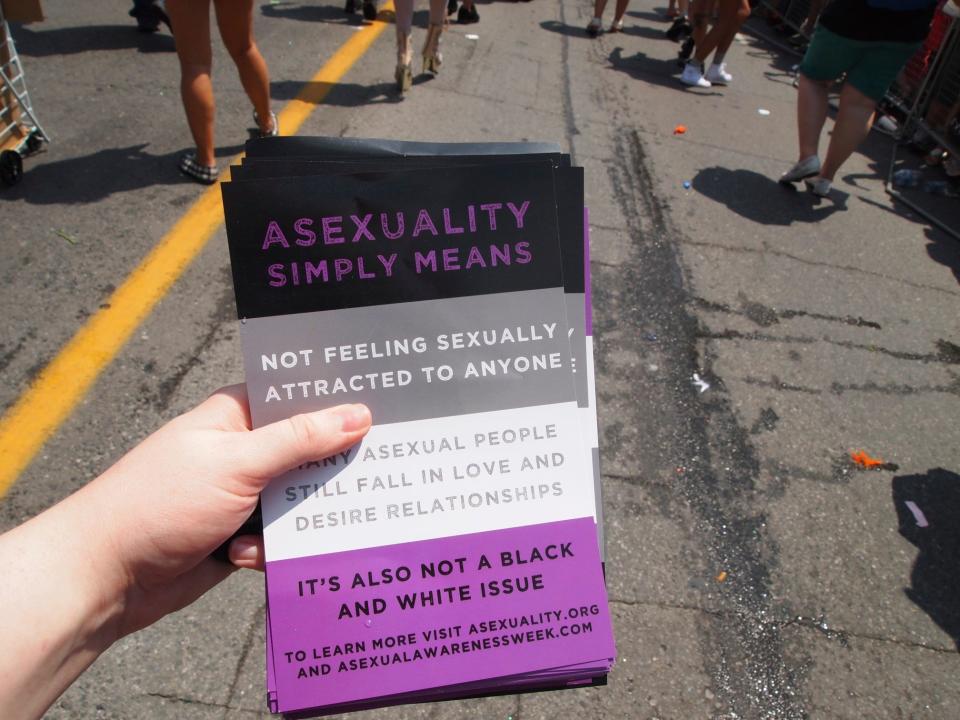What does asexual mean? Learning what the 'A' in LGBTQIA stands for.
According to a 2022 Gallup poll, 7.1% of U.S. adults self-identify as lesbian, gay, bisexual, transgender or something other than heterosexual.
Maybe you've seen or heard terms used in reference to someone's sexual orientation but are unsure of the exact definition. The best first step is to learn about the community. Asking your LGBTQ+ friends and family is an option, but be mindful of placing the burden of your education on others when there are so many resources at your disposal.
What does the 'A' in LGBTQIA for?
The A in LGBTQIA stands for asexual. LGBTQ is an acronym that's an identifier, and it has changed over the last few decades, adding new letters to the lineup.
What each letter in LGBTQ means:
G: Gay
T: Transgender (differs from the rest of the acronym as it relates to gender identity)
Q: Added to the lineup at the turn of the century to represent people identifying as queer, a more ambiguous term (reclaimed since its use as a derogatory term for LGBTQ individuals) allowing people to avoid rigid labels. Some also take the Q to mean questioning.
In recent years, many have added I and A — intersex and asexual — to the acronym. Additionally, a plus sign is often attached at the end to include identities in the community which may not fit into the other letters, such as pansexual, polyamorous, two-spirited or others who don’t want to label their sexuality.
What is asexuality? David Archuleta mentioned 'asexuality' in his coming out post. What is that?
Here's what you need to know: What people are getting wrong about asexuality (a lot)

What does asexual mean?
Asexuality is an umbrella term, and therefore being asexual exists on a spectrum. According to the Trevor Project, those who identify as asexual may have little interest in having sex, though they may desire emotionally intimate relationships.
An asexual person can be any gender or sex. As stated on whatisasexuality.com, "there is no asexual 'type'."
Other identities on the asexuality spectrum include:
Demisexual: People who are only sexual attracted when they form a strong emotional bond with another.
Gray-A/Gray ace: People who identify between being asexual and sexual.
Queerplatonic: People who experience non-romantic relationships where there is an intense emotional connection going beyond a traditional friendship.
Those who identify as asexual may experience emotional or aesthetic attraction to others. Emotional, or romantic, attraction can be defined as one's desire for deep connection with another. Aesthetic attraction is based on one's appreciation for another's appearance or physical beauty and does not always denote emotional or sexual attraction.
Asexual people may experience little to no desire when it comes to sexual attraction. Sexual attraction can be defined as a person's desire to be intimate with another. You can be sexually attracted to someone without experiencing romantic attraction.
What does the 'Q' in LGBTQ stand for? How the word 'queer' was reclaimed
What does the 'L' in LGBTQ stand for? What identifying as lesbian means.
What does ace mean?
Ace is a shortened term for asexual. Those who identify as ace may use the terms "hetero-," "homo-," "bi-," and "pan-" in front of the word "romantic" to describe who they experience attraction to.
For instance, someone who is homo-romantic may be emotionally attracted to someone of the same sex or gender, but not in a sexually attracted.
Pride Month is over. Here's how to be an ally to the LGBTQ community the rest of the year.
What does the 'T' in LGBTQ mean? Gender identity and the transgender, nonbinary communities
Misconceptions on asexuality
There are many misconceptions on asexuality and what it means to identify as asexual.
One misconception is asexuality is similar to abstinence or celibacy. Another misconception is that someone who identifies as asexual does so due to a bad relationship in the past. Neither of these are true.
Unlike celibacy or abstinence, which are temporary decisions based on personal beliefs or circumstances, asexuality is an orientation and identity; it is not a choice, but who someone is.
What are the colors of the asexual flag?
The colors of the asexual flag are black, gray, white and purple. According to the University of Illinois, Springfield, each color has its own meaning:
Black: Asexuality
Gray: Gray-Asexuality and Demisexuality
White: Non-asexual partners and allies
Purple: Community
LGBTQ Pride flags go beyond the classic rainbow. Here's what each one means
Resources
If you're questioning your identity or looking for how best to support your LGBTQ loved ones, these resources can help. Find organizations with free education, crisis intervention, peer support and information below:
Trevor Project: Call 866-488-7386, Text 678-678
24/7 Year round crisis intervention and suicide prevention services to lesbian, gay, bisexual, transgender and questioning (LGBTQ) young people ages 13-24.
400+ chapters across the country providing confidential peer support, education, and advocacy to LGBTQ+ people, their parents and families, and allies.
Crisis Text Line: Text START to 741-741
Free, 24/7 support for those in crisis. Text from anywhere in the U.S. to connect with a trained Crisis Counselor.
The Gay, Lesbian, Bisexual and Transgender National Hotline: 888-843-4564
The GLBT National Youth Talkline: (800) 246-7743
Youth serving youth through age 25
Education, awareness and resources
This article originally appeared on USA TODAY: What is asexuality? What the 'A' in LGBTQIA stands for.

